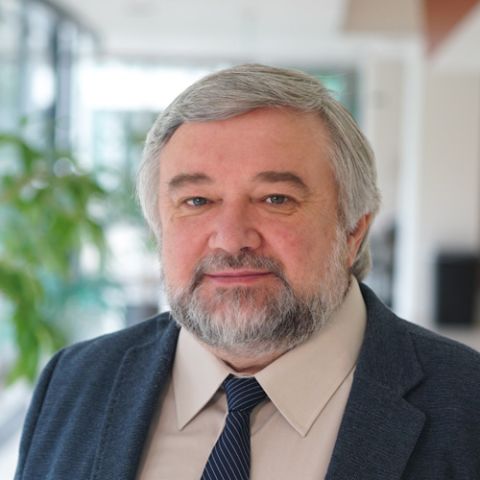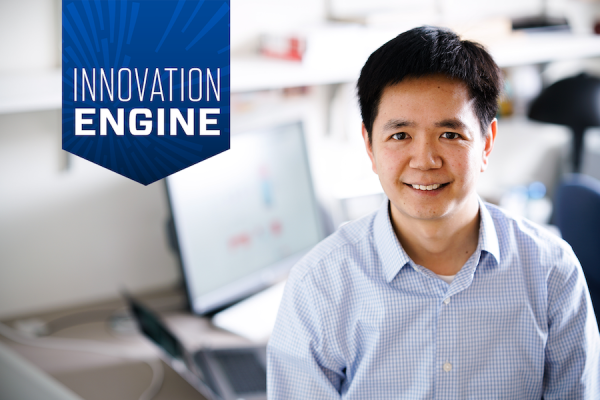Roswell Park scientists tackle the danger that looms when ancient viruses awaken.
The Innovation Engine series highlights high-impact Roswell Park science that advances the priorities of the National Cancer Plan — a roadmap for working together to end cancer as we know it. The work outlined in this post supports Goal #3: Develop Effective Treatments.
One of our strongest defenders in the battle against cancer is a gene called p53, known in the science world as “the guardian of the genome.” It’s the most important of several “tumor suppressors” that keep us safe by controlling cell division, repairing DNA damage and destroying abnormal cells. This gene is so important that in most cancers, it’s the one most likely to be disabled, often due to mutations, or changes, in DNA. Mutations can cause cells to behave abnormally. Sometimes they can even transform p53 from a protective gene into an oncogene, causing it to switch sides in the battle so that it can actually help the cancer grow.
A decade ago, research revealed a previously unknown way that non-mutated p53 protects us from cancer. Led by Andrei Gudkov, PhD, DSci, Senior Vice President of Research Technology and Innovation and the Garman Family Chair in Cell Stress Biology at Roswell Park Comprehensive Cancer Center, a team of scientists first demonstrated that p53 also silences, or suppresses, genetic elements called retrotransposons. About 40% of our DNA is made up of millions of copies of retrotransposons, often referred to as the “dark genome.”
Technically, retrotransposons are viruses that entered human DNA in the far-distant past and underwent several explosive expansions. In normal cells they’re inactive, hidden behind a dense layer of proteins. “They’re asleep in the DNA of our normal cells,” explains Dr. Gudkov.
But they become active in tumor cells, and like all viruses, they’re laser-focused on one thing: making copies of themselves. They insert those copies into places in our DNA where they don’t belong. “This process is very dangerous, because they can disrupt important genes in the new places they enter and cause other forms of DNA damage,” says Dr. Gudkov. “This can change the genetic program of cells and create new kinds of cells that can become cancerous. Cells with activated retrotransposons are like cells that contain a piece of uranium or radium.”
Thanks to that discovery by Dr. Gudkov’s lab — and follow-up work in his and other labs — today p53 is acknowledged as a silencer of the dark genome. While other control mechanisms also help keep the dark genome in check, p53 is especially important to that effort — and things go haywire when it’s unable to do its job. “In the absence of p53, the risk of the retrotransposons awakening increases dramatically,” says Dr. Gudkov.
Although p53 has great potential for preventing cancer, so far it has been impossible to develop drugs that would restore its lost function in tumor cells. But, the discovery that p53 acts as a silencer of retrotransposons provided a new opportunity to solve that puzzle.
The Roswell Difference
Pioneering innovation like this is part of what makes Roswell Park an "Exceptional" comprehensive cancer center, designated by the National Cancer Institute.
A new purpose for anti-HIV drugs
Dr. Gudkov and his colleagues came up with the idea of using a drug that could serve as a substitute for the disabled p53 gene and take over its job of silencing the retrotransposons. Retrotransposons replicate themselves using a process called reverse transcription, which relies on an enzyme called reverse transcriptase. It’s the same process used by HIV — the virus that causes AIDS — to replicate itself. Drugs called reverse transcriptase inhibitors, which block the HIV replication process, are essential ingredients in “drug cocktails” that keep the disease under control.
“Some of these drugs appeared to be quite effective ,” explains Dr. Gudkov. “This gave us the idea of repurposing those anti-HIV drugs to use in cancer cells in which retrotransposons are awake and actively expanding, to suppress the process and thereby partially restore p53 function.”
Studies conducted by Dr. Gudkov and his team went on to prove that the strategy works in preclinical models, dramatically extending remission time after chemotherapy. “Based on this result, we initiated a clinical trial at Roswell Park for people with one of the most challenging cancers — small cell lung cancer. We hope we can extend their life by extending the time of remission.”
Currently underway at Roswell Park under the direction of medical oncologist and lung cancer expert Grace Dy, MD, the study will enroll approximately 30 patients, who will receive standard treatment along with an anti-HIV drug to hit cancer with a one-two punch. Researchers at another U.S. cancer center have adopted the same approach in a study for patients with late-stage colorectal cancer, and the encouraging results have demonstrated its potential role in cancer therapy.
“This could provide a fantastic opportunity for improving any given cancer treatment by making it more reliable, with drugs we already have in place and simply need to repurpose from one disease to another,” says Dr. Gudkov.
Dark genome research may point to better screening and treatment options
Additional insight into the dark genome grew from other recent research led by Dr. Gudkov and his colleagues, who showed that humans can develop an immune response against retrotransposons, generating high levels of antibodies against their encoded proteins. This response is especially strong in some patients with lung, pancreatic, ovarian, liver and esophageal cancer, which are among the deadliest cancers. Often called “silent killers,” they usually don’t cause symptoms until the disease has progressed to the late stages, when a cure is far less likely. But antibodies against retrotransposons can be detected in the blood of these patients even in the early stages and could serve as a red flag to indicate the presence of disease when it’s more treatable.
“This discovery sets the stage for the development of improved diagnostics and immunotherapies for these challenging cancers,” says Dr. Gudkov.
What’s ahead? “If we could create immunotherapies directed at the cells linked to retrotransposons, it would mark a significant breakthrough in the prevention and treatment of various types of cancer,” says Dr. Gudkov. “This is a long road, but we’re on the way.”





